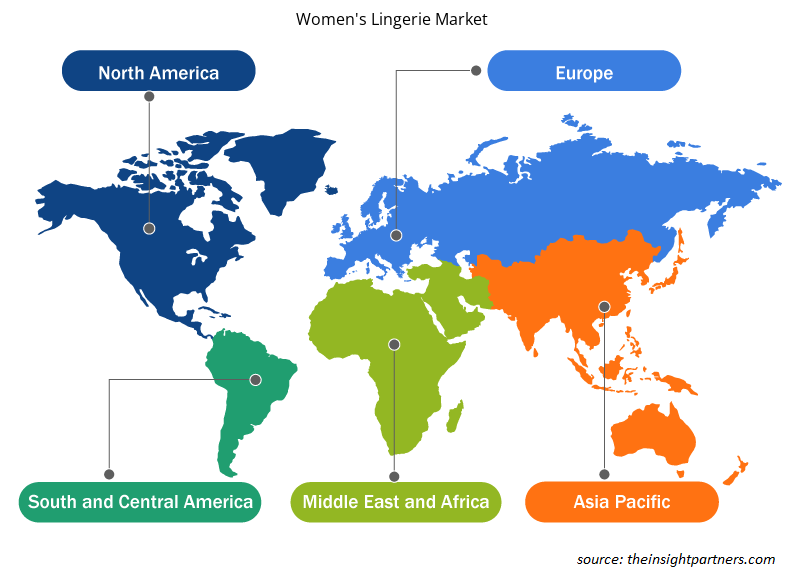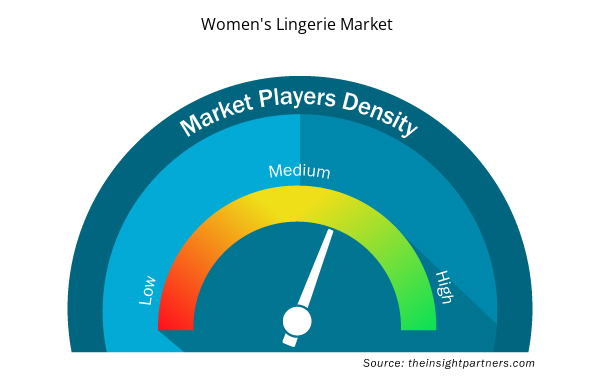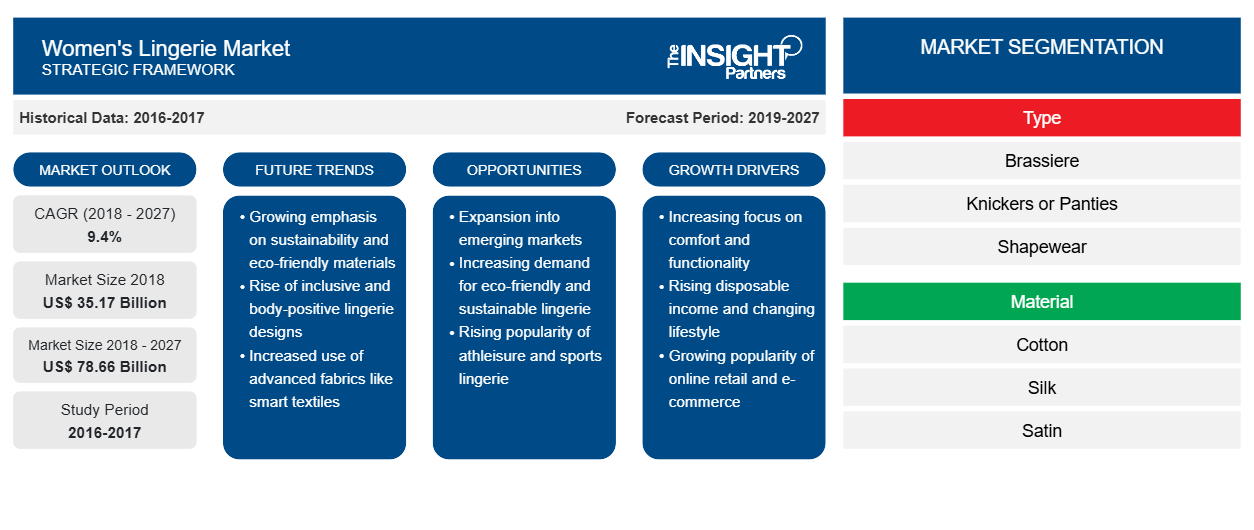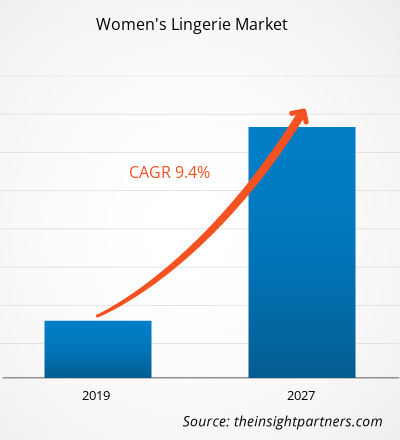El mercado de lencería femenina se valoró en US$ 35.169,4 millones en 2018 y se proyecta que alcance los US$ 78.662,5 millones en 2027, creciendo a una CAGR del 9,4% entre 2019 y 2027.
La palabra lencería es un término tomado del idioma francés, que significa ropa interior, y se usa específicamente para artículos más livianos de ropa interior femenina. La palabra francesa original se deriva de la antigua palabra francesa lencería, que significa lino. La lencería es una prenda de vestir femenina que está hecha de telas livianas, suaves, transparentes y elásticas. El mercado de lencería femenina se caracteriza por cuatro tipos principales, como sujetadores, braguitas o bragas, fajas y otros. El mercado de lencería femenina se caracteriza por materiales como satén, algodón, seda, nailon y otros. El mercado de lencería femenina utiliza diferentes canales para suministrar el producto a sus consumidores, como Internet, tiendas especializadas, etc.
Se espera que América del Norte sea el sector comercial de más rápido crecimiento para la lencería femenina mundial en los próximos años. La creciente conciencia sobre el mejor ajuste, la creación de masas de millennials y el aumento del poder adquisitivo entre las mujeres son necesarios para impulsar el mercado durante el período de pronóstico. La creciente accesibilidad de una amplia gama de productos en diversas ocasiones para diversos propósitos, como juegos, ropa de boda y ropa estándar, ha impulsado el mercado de lencería femenina en la región. Asimismo, la mayor accesibilidad de los productos, junto con la mayor entrada de canales en línea y fuera de línea, es uno de los factores clave que impulsan el mercado de lencería femenina en la región. La presencia de innumerables actores del mercado, como L-Brands Inc., Gap Inc., Hanesbrands Inc. y Jockey International, Inc., que ofrecen enormes surtidos de lencería femenina, por ejemplo, sujetadores con aros con acolchado suave, sujetadores reductores de lazo de estructura y belleza, sujetadores deportivos con espalda de nadador, braguitas de mujer de moda de corte medio, es un impulsor esencial para el mercado de lencería femenina de América del Norte.
El brote de COVID-19 comenzó en Wuhan (China) durante diciembre de 2019 y desde entonces se ha extendido a un ritmo rápido por todo el mundo. A partir de mayo de 2020, China, Italia, Irán, España, la República de Corea, Francia, Alemania y los EE. UU. son algunos de los países más afectados en términos de casos confirmados y muertes reportadas. Según las últimas cifras de la OMS, hay ~ 5.728.642 casos confirmados y 353.692 muertes en total a nivel mundial. El COVID-19 ha estado afectando a las economías e industrias en varios países debido a los cierres, las prohibiciones de viaje y los cierres de negocios. La industria mundial de la moda y la indumentaria es una de las principales industrias que se enfrenta a graves interrupciones, como interrupciones de la cadena de suministro, cierres de oficinas, cierres de centros comerciales, tiendas, tiendas minoristas o tiendas de marca, etc. como resultado de este brote. Por ejemplo, China es el centro mundial de fabricación y el mayor proveedor de materias primas para varias industrias y también es uno de los países más afectados. El cierre de varias plantas y fábricas en China está afectando a las cadenas de suministro globales y afectando negativamente a la fabricación, los plazos de entrega y las ventas de diversos productos, incluida la ropa. Varias empresas ya han anunciado posibles retrasos en las entregas de productos y una caída en las ventas futuras de sus productos. Además de esto, las prohibiciones de viaje globales impuestas por países de Europa, Asia y América del Norte están afectando las colaboraciones comerciales y las oportunidades de asociación. Se prevé que todos estos factores afecten a la industria de la moda y la confección de manera negativa y, por lo tanto, actúen como un factor restrictivo para el crecimiento de varios mercados relacionados con esta industria en los próximos meses.lockdowns, travel bans, and business shutdowns. The global fashion and apparel industry is one of the major industries that is facing serious disruptions such as supply chain breaks, office shutdowns, shutdown of malls, shops, retail stores or brand stores etc. as a result of this outbreak. For instance, China is the global hub of manufacturing and largest raw material supplier for various industries and it is also one of the worst affected countries. The lockdown of various plants and factories in China is affecting the global supply chains and negatively impacting the manufacturing, delivery schedules, and sales of various goods including apparel. Various companies have already announced possible delays in product deliveries and slump in future sales of their products. In addition to this, the global travel bans imposed by countries in Europe, Asia, and North America are affecting the business collaborations and partnerships opportunities. All these factors are anticipated to affect the fashion and apparel industry in a negative manner and thus act as restraining factor for the growth of various markets related to this industry in the coming months.
Personalice este informe según sus necesidades
Obtendrá personalización en cualquier informe, sin cargo, incluidas partes de este informe o análisis a nivel de país, paquete de datos de Excel, así como también grandes ofertas y descuentos para empresas emergentes y universidades.
- Obtenga las principales tendencias clave del mercado de este informe.Esta muestra GRATUITA incluirá análisis de datos, desde tendencias del mercado hasta estimaciones y pronósticos.
Perspectivas del mercado
La oferta innovadora de productos para satisfacer la demanda de lencería de moda entre los clientes está impulsando el crecimiento del mercado a nivel mundial
Existe un creciente interés por la ropa interior elegante entre las mujeres de todo el mundo, que se infiere de la creciente conciencia sobre el mejor ajuste, el estilo y la comodidad de la ropa interior. Además del crecimiento de la población millennial, la creciente conciencia de marca y la alta capacidad de gasto entre las mujeres trabajadoras están creando una oportunidad gratificante para que los actores del mercado lleguen a más clientes con lencería creativa y ropa íntima para mujeres. La inclinación de los clientes por los artículos con adornos, tejidos, materiales suntuosos y colores más espléndidos, está contribuyendo positivamente a que los fabricantes presenten nuevos artículos en el mercado. La mayoría de las mujeres de los países desarrollados y en desarrollo, por ejemplo, Estados Unidos, Canadá, Italia, el Reino Unido, Rusia, Japón, China, los Emiratos Árabes Unidos y Arabia Saudita están gastando más dinero en usar ropa interior moderna y de moda para diversas ocasiones. Los fabricantes y proveedores pueden aumentar el máximo beneficio y atraer a los compradores ofreciendo artículos con mejores características que nunca. Se prevé que el desarrollo de productos innovadores y estrategias de marketing sólidas ayuden al desarrollo general del mercado de lencería femenina y fortalezcan la situación de los actores del mercado en el mercado mundial.
Tipo de información
Según el tipo, el mercado de lencería femenina se segmenta en sujetadores, braguitas o bragas, fajas y otros. En 2018, el segmento de sujetadores representó la mayor parte del mercado mundial de lencería femenina, mientras que se espera que el segmento Otros crezca a una tasa compuesta anual más rápida. El segmento Otros incluye babydolls y camisones, camisolas, corsés y bustiers, monos y teddies, etc. La amplia disponibilidad de esta lencería femenina junto con el cambio en el estilo de vida del consumidor y la conciencia sobre la apariencia física personal han sido factores clave para el crecimiento del segmento Otros en el mercado de lencería femenina.
Información sobre materiales
Según el material, el mercado de lencería femenina se segmenta en algodón, seda, satén, nailon y otros. En 2018, el segmento de algodón lideró el mercado con el mercado más alto, seguido de la seda. Se sabe que el charmeuse de seda es uno de los tejidos más lujosos que se prefieren para usar cerca de la piel. Tiene un tejido de satén que le da un alto brillo y proporciona una apariencia casi líquida. Ha sido popular en la producción de lencería desde principios del siglo XX y todavía se usa constantemente en lencería de alta gama. Muchos sujetadores de diseñador se crean con una mezcla de seda y licra, también conocida como charmeuse de seda elástica. El tejido de forro más utilizado es la seda china, que puede ser una opción relativamente económica para la ropa interior, incluidas las combinaciones. Es muy suave al cuerpo y muy fina, por lo que no agrega volumen. El crepé de seda se usa para hacer ropa de estar por casa, pijamas, batas, combinaciones y camisones de lujo.
Información sobre el canal de distribución
Según el canal de distribución, el mercado de lencería femenina se segmenta en grandes superficies, tiendas especializadas, tiendas online y otras. Las tiendas especializadas han liderado el mercado mundial de lencería femenina con la mayor cuota de mercado, seguidas de otras que incluyen los canales de distribución no organizados. El otro segmento de los canales de distribución de lencería femenina incluye tiendas departamentales, tiendas de variedades, mercados callejeros, etc. Estos minoristas venden múltiples productos, incluidos sujetadores, braguitas o bragas, fajas, babydoll, corsés, bodys y otros de varias marcas nacionales y locales. El bajo coste es el principal factor que atrae a los clientes a comprar en estos canales.
El desarrollo de productos, las fusiones y adquisiciones, y estrategias como acuerdos de licencia y distribución, asociaciones con distribuidores, contratos de proyectos y mejoras en los canales de distribución y ventas son comúnmente adoptadas por las empresas para expandir su presencia en todo el mundo, lo que está afectando aún más el tamaño del mercado. Los actores del mercado mundial de lencería femenina se dedican principalmente al desarrollo de productos para satisfacer la creciente demanda debido a las preferencias en constante cambio por la ropa íntima.
Alcance del informe sobre el mercado de lencería femenina
Perspectivas regionales del mercado de lencería femenina
Los analistas de Insight Partners explicaron en detalle las tendencias y los factores regionales que influyen en el mercado de lencería femenina durante el período de pronóstico. Esta sección también analiza los segmentos y la geografía del mercado de lencería femenina en América del Norte, Europa, Asia Pacífico, Oriente Medio y África, y América del Sur y Central.

- Obtenga datos regionales específicos para el mercado de lencería femenina
Alcance del informe sobre el mercado de lencería femenina
| Atributo del informe | Detalles |
|---|---|
| Tamaño del mercado en 2018 | US$ 35,17 mil millones |
| Tamaño del mercado en 2027 | US$ 78,66 mil millones |
| Tasa de crecimiento anual compuesta (CAGR) global (2018-2027) | 9,4% |
| Datos históricos | 2016-2017 |
| Período de pronóstico | 2019-2027 |
| Segmentos cubiertos | Por tipo
|
| Regiones y países cubiertos | América del norte
|
| Líderes del mercado y perfiles de empresas clave |
|
Densidad de actores del mercado: comprensión de su impacto en la dinámica empresarial
El mercado de lencería femenina está creciendo rápidamente, impulsado por la creciente demanda de los usuarios finales debido a factores como la evolución de las preferencias de los consumidores, los avances tecnológicos y una mayor conciencia de los beneficios del producto. A medida que aumenta la demanda, las empresas amplían sus ofertas, innovan para satisfacer las necesidades de los consumidores y aprovechan las tendencias emergentes, lo que impulsa aún más el crecimiento del mercado.
La densidad de actores del mercado se refiere a la distribución de las empresas o firmas que operan dentro de un mercado o industria en particular. Indica cuántos competidores (actores del mercado) están presentes en un espacio de mercado determinado en relación con su tamaño o valor total de mercado.
Las principales empresas que operan en el mercado de lencería femenina son:
- Brecha Inc.
- Triunfo internacional
- Marca: Hanesbrands Inc.
- Jockey Internacional, Inc.
- Hunkemöller International BV
Descargo de responsabilidad : Las empresas enumeradas anteriormente no están clasificadas en ningún orden particular.

- Obtenga una descripción general de los principales actores clave del mercado de lencería femenina
Mercado mundial de lencería femenina: por tipo
- Sostén
- Braguitas o bragas
- Fajas moldeadoras
- Otros
Mercado mundial de lencería femenina: por material
- Algodón
- Seda
- Satín
- Nylon
- Otros
Mercado mundial de lencería femenina: por canal de distribución
- Grandes distribuidores
- Tiendas especializadas
- En línea
- Otros
Perfiles de empresas
- Brecha Inc.
- Triunfo internacional
- Marca: Hanesbrands Inc.
- Jockey Internacional, Inc.
- Hunkemöller International BV
- Participaciones MAS
- Corporación PVH.
- Marcas L
- Grupo Chnatelle
- Hanky Panky
- Análisis histórico (2 años), año base, pronóstico (7 años) con CAGR
- Análisis PEST y FODA
- Tamaño del mercado Valor/volumen: global, regional, nacional
- Industria y panorama competitivo
- Conjunto de datos de Excel



Report Coverage
Revenue forecast, Company Analysis, Industry landscape, Growth factors, and Trends

Segment Covered
This text is related
to segments covered.

Regional Scope
North America, Europe, Asia Pacific, Middle East & Africa, South & Central America

Country Scope
This text is related
to country scope.
Preguntas frecuentes
Fast changing consumer preferences for fashionable apparel products is driving the market growth for women’s lingerie. Lingerie is a category of women's clothing, including undergarments (mostly brassieres), sleepwear, and lightweight robes. The lingerie concept is a visually appealing undergarment, which was developed during the late nineteenth century. Consumers now days are quite aware of latest fashion trends, which are influencing the market for women’s lingerie. Also, growth in the e-commerce industry is again helping in the market growth. Most of the prominent market players, including Gap Inc., Hanesbrands Inc., Jockey International Inc., PVH Corp, L Brands, and among others display sell their lingerie items in online platforms. Purchasing products online is always a convenient and reliable option, owing to the efficient worldwide distribution network; it gets delivered on the stipulated timeline.
The brassiere women’s lingerie segment led the women’s lingerie market in 2018 with a significant share and is expected to continue its dominance during the forecast period. Brassiere or bra is a type of lingerie worn by preteen, teens, girls, and women to cover, support, and elevate the breasts, and it also shapes the wearer’s figure. The level at which the bra frames the breasts varies between style, fashion, functionality, and fabrics. There are different types of bra available in the market that are suitable for different body and breast shapes, and also for different occasions. The brassiere is essential to be in the perfect figure lines called for by the prevailing fashions. Manufacturers produce a huge variety of brassieres that serve a variety of purposes.
The women’s lingerie market was dominated by Europe, with a significant market share in 2018 and will continue to dominate the market by 2027. North-America is the second-largest contributor to the global women’s lingerie market, followed by APAC. The trend of fancy and fashionable lingerie among the female population is driving the market growth in the country. Along with this, the demand for comfortable and functional lingerie is growing among the customers, especially working females, thus encouraging manufacturers to innovate a new range of fabrics such as nylon, polyester, satin, lace, sheer, spandex, silk, and cotton for lingerie manufacturing. Consumers are more attracted to color, fabric, and style, which is encouraging the manufacturers to introduce trendy lingerie suitable for various activities.
Trends and growth analysis reports related to Consumer Goods : READ MORE..
The List of Companies - Women’s Lingerie Market
- Gap Inc.
- Triumph International
- Hanesbrands Inc.
- Jockey International, Inc.
- Hunkemöller International B.V.
- MAS Holdings
- PVH Corp.
- L Brands
- Chantelle Group
- Hanky Panky
The Insight Partners performs research in 4 major stages: Data Collection & Secondary Research, Primary Research, Data Analysis and Data Triangulation & Final Review.
- Data Collection and Secondary Research:
As a market research and consulting firm operating from a decade, we have published and advised several client across the globe. First step for any study will start with an assessment of currently available data and insights from existing reports. Further, historical and current market information is collected from Investor Presentations, Annual Reports, SEC Filings, etc., and other information related to company’s performance and market positioning are gathered from Paid Databases (Factiva, Hoovers, and Reuters) and various other publications available in public domain.
Several associations trade associates, technical forums, institutes, societies and organization are accessed to gain technical as well as market related insights through their publications such as research papers, blogs and press releases related to the studies are referred to get cues about the market. Further, white papers, journals, magazines, and other news articles published in last 3 years are scrutinized and analyzed to understand the current market trends.
- Primary Research:
The primarily interview analysis comprise of data obtained from industry participants interview and answers to survey questions gathered by in-house primary team.
For primary research, interviews are conducted with industry experts/CEOs/Marketing Managers/VPs/Subject Matter Experts from both demand and supply side to get a 360-degree view of the market. The primary team conducts several interviews based on the complexity of the markets to understand the various market trends and dynamics which makes research more credible and precise.
A typical research interview fulfils the following functions:
- Provides first-hand information on the market size, market trends, growth trends, competitive landscape, and outlook
- Validates and strengthens in-house secondary research findings
- Develops the analysis team’s expertise and market understanding
Primary research involves email interactions and telephone interviews for each market, category, segment, and sub-segment across geographies. The participants who typically take part in such a process include, but are not limited to:
- Industry participants: VPs, business development managers, market intelligence managers and national sales managers
- Outside experts: Valuation experts, research analysts and key opinion leaders specializing in the electronics and semiconductor industry.
Below is the breakup of our primary respondents by company, designation, and region:

Once we receive the confirmation from primary research sources or primary respondents, we finalize the base year market estimation and forecast the data as per the macroeconomic and microeconomic factors assessed during data collection.
- Data Analysis:
Once data is validated through both secondary as well as primary respondents, we finalize the market estimations by hypothesis formulation and factor analysis at regional and country level.
- Macro-Economic Factor Analysis:
We analyse macroeconomic indicators such the gross domestic product (GDP), increase in the demand for goods and services across industries, technological advancement, regional economic growth, governmental policies, the influence of COVID-19, PEST analysis, and other aspects. This analysis aids in setting benchmarks for various nations/regions and approximating market splits. Additionally, the general trend of the aforementioned components aid in determining the market's development possibilities.
- Country Level Data:
Various factors that are especially aligned to the country are taken into account to determine the market size for a certain area and country, including the presence of vendors, such as headquarters and offices, the country's GDP, demand patterns, and industry growth. To comprehend the market dynamics for the nation, a number of growth variables, inhibitors, application areas, and current market trends are researched. The aforementioned elements aid in determining the country's overall market's growth potential.
- Company Profile:
The “Table of Contents” is formulated by listing and analyzing more than 25 - 30 companies operating in the market ecosystem across geographies. However, we profile only 10 companies as a standard practice in our syndicate reports. These 10 companies comprise leading, emerging, and regional players. Nonetheless, our analysis is not restricted to the 10 listed companies, we also analyze other companies present in the market to develop a holistic view and understand the prevailing trends. The “Company Profiles” section in the report covers key facts, business description, products & services, financial information, SWOT analysis, and key developments. The financial information presented is extracted from the annual reports and official documents of the publicly listed companies. Upon collecting the information for the sections of respective companies, we verify them via various primary sources and then compile the data in respective company profiles. The company level information helps us in deriving the base number as well as in forecasting the market size.
- Developing Base Number:
Aggregation of sales statistics (2020-2022) and macro-economic factor, and other secondary and primary research insights are utilized to arrive at base number and related market shares for 2022. The data gaps are identified in this step and relevant market data is analyzed, collected from paid primary interviews or databases. On finalizing the base year market size, forecasts are developed on the basis of macro-economic, industry and market growth factors and company level analysis.
- Data Triangulation and Final Review:
The market findings and base year market size calculations are validated from supply as well as demand side. Demand side validations are based on macro-economic factor analysis and benchmarks for respective regions and countries. In case of supply side validations, revenues of major companies are estimated (in case not available) based on industry benchmark, approximate number of employees, product portfolio, and primary interviews revenues are gathered. Further revenue from target product/service segment is assessed to avoid overshooting of market statistics. In case of heavy deviations between supply and demand side values, all thes steps are repeated to achieve synchronization.
We follow an iterative model, wherein we share our research findings with Subject Matter Experts (SME’s) and Key Opinion Leaders (KOLs) until consensus view of the market is not formulated – this model negates any drastic deviation in the opinions of experts. Only validated and universally acceptable research findings are quoted in our reports.
We have important check points that we use to validate our research findings – which we call – data triangulation, where we validate the information, we generate from secondary sources with primary interviews and then we re-validate with our internal data bases and Subject matter experts. This comprehensive model enables us to deliver high quality, reliable data in shortest possible time.


 Obtenga una muestra gratuita de este informe
Obtenga una muestra gratuita de este informe